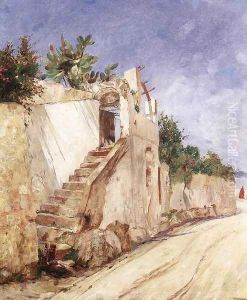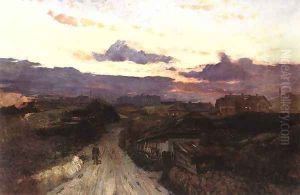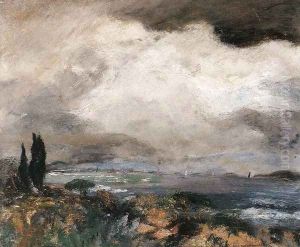Gusztav Magyar-Mannheimer Paintings
Gusztav Magyar-Mannheimer was a Hungarian painter known for his contributions to art during the late 19th and early 20th centuries. Born in 1884 in Hungary, he lived through a transformative period in European art, experiencing the shifts from traditional academic painting to the modernist movements that would redefine the art world.
Magyar-Mannheimer's early years were marked by rigorous academic training. He was educated at the Hungarian University of Fine Arts, where he honed his skills in the classical techniques of painting. His early works were characterized by a strong adherence to the academic style, with an emphasis on historical and mythological subjects, as well as portraits and landscapes. These pieces were marked by their detailed realism and often contained allegorical or narrative elements.
As the years progressed, Magyar-Mannheimer's style evolved, showing an awareness of the emerging trends in European art. While he never fully abandoned his classical roots, his later works began to display a greater sense of experimentation with form and color, reflecting the influence of Impressionism and Post-Impressionism. Despite this, he never aligned himself explicitly with any avant-garde movement, choosing instead to develop a personal style that remained distinct and somewhat eclectic.
Throughout his career, Magyar-Mannheimer participated in numerous exhibitions and was recognized for his artistic talents. His works were well-received, and he developed a reputation for his portraiture, capturing the likeness and personality of his subjects with a keen eye for detail and a sensitive handling of paint.
Magyar-Mannheimer's legacy is one of a transitional figure in Hungarian art, bridging the gap between the academic traditions of the 19th century and the more fluid, expressive approaches that would dominate the 20th century. Despite the overshadowing presence of more radical movements in European art, his work maintained a steady popularity, and his paintings can still be found in the collections of Hungarian museums and galleries.
The artist lived a long life, continuing to paint and exhibit well into his later years. Gusztav Magyar-Mannheimer passed away in 1966, leaving behind a rich body of work that continues to be appreciated for its craftsmanship and subtle interplay between tradition and innovation.


